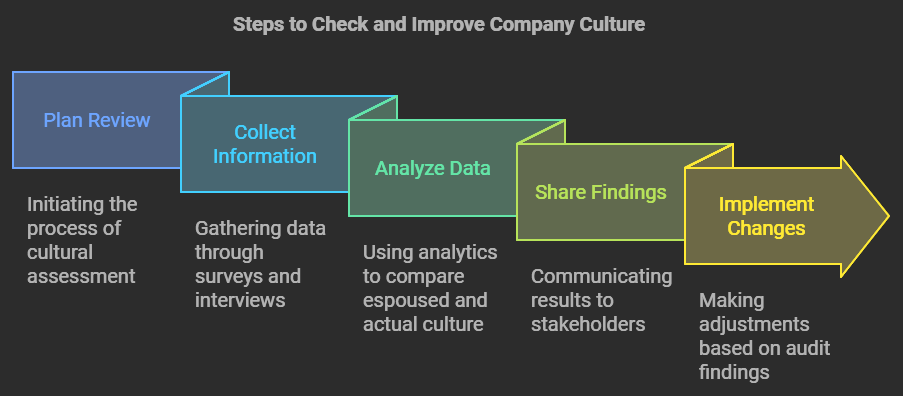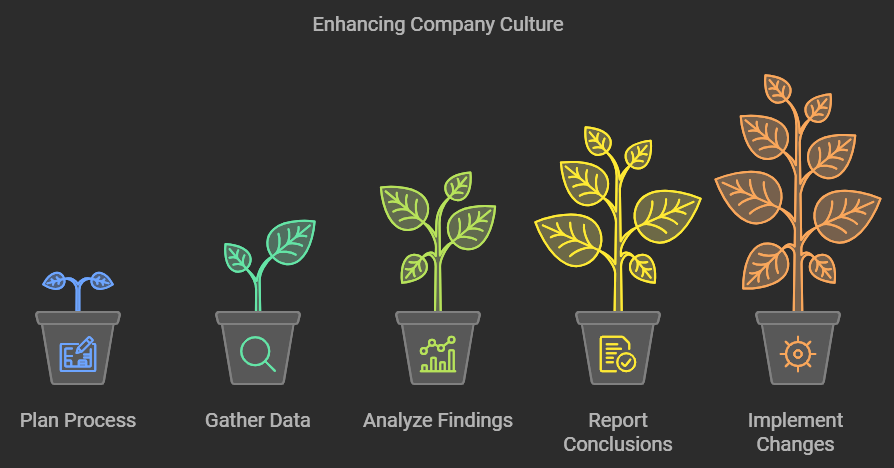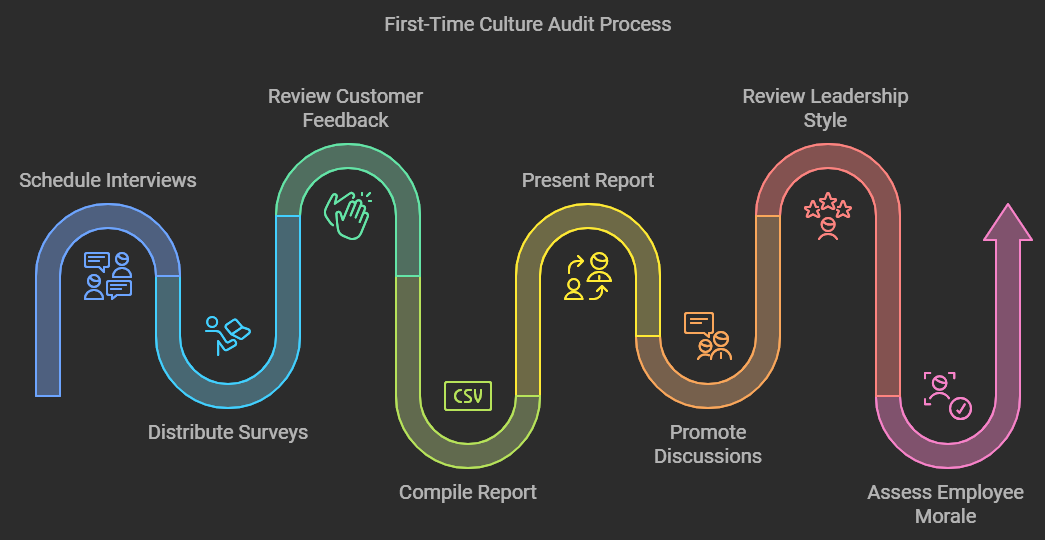Your Culture Checklist: Organizational Culture Audit
Organizational culture is vital for a company’s success. But how can you measure and evaluate it? One way is by performing an organizational culture audit. This checklist helps you assess strengths and weaknesses, identify areas for improvement, and create a plan for shaping your organizational culture.
In this article, we will guide you through the process to ensure your company is on the path to success.
What’s a Culture Audit?
Understanding What Organizational Culture Is
A culture audit evaluates an organization’s values, beliefs, behaviors, and practices. This helps understand the current workplace culture and identify areas for improvement. It involves assessing the invisible belief systems and values of individuals within an organization and how these impact behavior and decision-making.
Checking a company’s culture is important because it directly impacts employee engagement and business success. A healthy culture fosters a positive work environment, reduces turnover, and enhances productivity. It also helps in identifying and addressing issues such as toxic management, discrimination, low morale, and high turnover, thereby improving overall organizational effectiveness.
When examining a company’s culture, key elements to consider include leadership, reputation, people management, and key processes. It is essential to assess their alignment with the desired organizational culture to ensure that the espoused culture aligns with the organization’s reality.
Additionally, examining leadership’s role in managing and embodying the culture and the need for alignment in people management practices and key organizational processes is crucial to understanding and improving the company’s culture.
Why Should We Check Our Company’s Culture?

Regularly checking and assessing a company’s culture can provide valuable insight. It helps identify potential improvement areas, enhance employee satisfaction, and foster a positive work environment.
Analyzing the company’s culture can optimize internal operations, achieve better strategic alignment, and boost organizational performance. Companies can improve overall success and enhance employee satisfaction by identifying and addressing cultural issues.
A company’s culture can directly impact its reputation and ability to attract and retain talented employees. A positive and inclusive culture can amplify a company’s appeal, leading to higher employee engagement, better recruitment, and increased employee retention.
In contrast, a negative culture can deter potential employees, damage the company’s reputation, and impede its ability to attract and retain talented individuals.
Steps to Check Your Company’s Culture

Plan Your Review
When planning a review of your company’s culture, it’s important to consider:
- Identifying cultural levers
- Assessing leadership’s role
- Evaluating people management practices
- Examining key organizational processes
Collecting and analyzing information during a culture review is important because it provides valuable insights into the current workplace culture and identifies areas for improvement. It also helps in understanding the impact of culture on employee engagement and business success.
Sharing the findings of a culture audit with others in the company can lead to positive changes. It creates awareness about existing cultural issues, increases transparency and accountability, and fosters a collaborative effort to address and improve the organizational culture. This can ultimately result in a healthier and more productive work environment.
Collect Info
When conducting a culture audit, gathering specific information about leadership, reputation, people management, and key organizational processes is important. This includes data on employee attitudes, perceptions, and behaviors. Feedback from surveys, interviews, and customer reviews is also important.
This information gives insight into the organizational culture by showing how well the espoused culture aligns with the actual culture. It also helps identify strengths, areas for improvement, and cultural factors that significantly impact the company’s culture.
Additionally, the collected information provides a better understanding of how the culture affects employee engagement, decision-making, and overall business performance.
Look at What Your Info Tells You
Gather specific information to check a company’s culture. This includes data about leadership practices, people management, and key organizational processes. The audit should also assess how well these cultural elements match the desired organizational culture, helping to gain valuable insights.
After collecting the information, analyze it using audit programs and data analytics. This ensures that the espoused culture matches the reality of the organization.
To communicate and use the findings, the internal audit team should report their conclusions and recommend necessary changes. It’s also important to dedicate resources to impact the organization’s culture. This includes addressing cultural issues like toxic management, discrimination, low morale, and high turnover.
Tell Others About What You Found
After conducting a culture audit, the company learned a lot about its culture. They examined things like leadership, reputation, how they manage people, and key processes. This helped them see if their culture matched the one they wanted. The audit showed how important it is to have leaders who live out the culture and for people management and key processes to match it, too. After the audit, the company shared what they found in a detailed report.
They used surveys, interviews, and customer reviews to get the information. As a result of the audit, the company changed some of its practices and behaviors to match the desired culture. They worked on lousy management, discrimination, low morale, and high turnover to make the culture healthier and happier.
Make Changes Based on What You Found
Organizations can make specific changes based on a culture audit. These changes include implementing new leadership training programs, revising people management practices, and reengineering key organizational processes. These changes can drive organizational improvement by addressing cultural issues like toxic management, discrimination, low morale, and high turnover.
The results of a culture audit can help allocate resources to positively impact an organization’s culture and promote growth. To implement changes, organizations need to analyze the gathered data, identify areas for improvement, and create an action plan. This involves collaborating with all levels of the organization to ensure that desired cultural changes are effectively implemented and sustained.
Key Parts When You Look at Your Culture

Reputation and How People See Your Company
The company’s reputation shapes how others see it.
For instance, if the organization is known for social responsibility, ethics, and community involvement, it will be viewed positively.
Also, the behavior of the company’s leaders greatly influences perception.
If leaders demonstrate the company’s values, treat employees fairly, and are transparent and accountable, this can positively impact the company’s image.
Indicators like customer feedback and employee satisfaction surveys provide valuable insights.
These measurements help identify strengths and areas for improvement, potentially enhancing the company’s overall reputation.
Leaders and How They Guide Everyone
Leaders guide everyone in a company’s culture by showing the values and behaviors they want. They set the tone for the whole organization by how they act and decide things. They also shape how people are treated and how the company is seen. Their leadership style and interaction with employees affect the workplace atmosphere and morale. Leaders need to be part of reviewing and making changes based on the company’s culture audit.
Their support is important for making any cultural improvements happen. Without their involvement, it’s hard to make real change and match the organization’s practices with the desired cultural values. Leaders’ participation in this process means that the cultural audit results are taken seriously and the changes are done well.
The Way People in the Company Are Treated
The company treats its employees well. It values their well-being and ensures fair treatment and opportunities for all.
Leadership focuses on respect, diversity, and inclusion. People management practices emphasize equality.
The organization uses audit programs and data analytics to ensure the workplace culture matches the reality.
By doing a culture audit, the company can identify areas for improvement and make changes to enhance employee treatment and the work environment.
How to Know If Your Company’s Doing Things Right
Checking your company’s culture is crucial. It affects behavior, decision-making, employee engagement, and the business’s success. When evaluating your company’s culture, look at leadership, reputation, people management, and organizational processes to see if they align with the desired culture. Here are some tips for conducting your first culture audit:
- Plan the process
- Gather data through surveys, interviews, and customer reviews
- Analyze findings
- Report conclusions
- Make changes based on the audit results.
Tips for Your First Time Checking Your Culture

When planning their first culture audit, organizations should:
- Schedule interviews with employees at all levels
- Distribute anonymous surveys
- Review customer feedback to gain insight into the current company culture.
After gathering this information, they can:
- Communicate the findings by compiling a detailed report with actionable recommendations
- Present the report to all key stakeholders
- Promote open discussions to share and address the results company-wide.
When conducting a culture audit for the first time, it’s important to review factors such as:
- Leadership style and behavior
- Employee morale and satisfaction
- Communication within the organization
- The alignment of organizational processes with desired cultural values.
Furthermore, organizations should seek to understand how external perceptions influence the internal culture.
Quick Tips to Review Your Company’s Culture
Focus on One Part at a Time

When conducting a culture audit within an organization, it’s important to focus on specific cultural areas, such as leadership, reputation, people management, and key processes.
By examining these elements separately, internal audit teams can better understand how they align with the desired organizational culture and spot any areas of misalignment.
Reviewing one part at a time allows for a more thorough analysis, leading to targeted strategies for improvement. For example, by looking at leadership’s role in embodying the culture and assessing people management practices and key processes, cultural issues like toxic management, discrimination, low morale, and high turnover can be addressed more effectively.
This focused approach can bring about more significant changes in an organization’s culture, ensuring that the expressed culture matches the organization’s reality.
Remember that Change Takes Time

It’s important to remember that change takes time when reviewing your company’s culture because culture transformation is not an overnight process. Organizations need to recognize that cultural change is a journey that requires patience and consistency to yield long-lasting results. Rushing through the process may lead to superficial changes rather than a deep-rooted cultural shift.
By acknowledging that change takes time, companies can manage expectations and invest in sustainable, effective strategies for cultural transformation.
One way to ensure that cultural change is given the necessary time and attention is to align leadership, reputation, people management, and key processes with the desired organizational culture. Assessing the current cultural levers and carefully evaluating their alignment with the intended culture is essential.
Additionally, using audit programs and data analytics to assess these aspects can provide valuable insights and ensure that the espoused culture aligns with the organization’s reality. By focusing on these factors and taking a holistic approach to cultural change, organizations can lay a strong foundation for lasting change.
Ask Questions About Culture Audits
To check a company’s culture, an organization should take specific steps. These include:
- Planning the process
- Gathering data through surveys, interviews, and customer reviews
- Analyzing findings
- Reporting conclusions
- Making changes based on the audit results
When examining a company’s culture, it’s important to consider key parts such as:
- Leadership
- Reputation
- People management
- Key processes
It’s also important to assess their alignment with the desired organizational culture.
For first-time culture audits, it is recommended to focus on:
- Identifying cultural levers
- Examining leadership’s role in managing and embodying the culture
- Ensuring alignment in people management practices and key organizational processes
These tips and best practices are important for successfully evaluating and maintaining a healthy company culture.

Vizologi is a revolutionary AI-generated business strategy tool that offers its users access to advanced features to create and refine start-up ideas quickly.
It generates limitless business ideas, gains insights on markets and competitors, and automates business plan creation.


